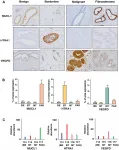(Press-News.org) COVID-19 vaccines being rolled out in the UK are effective in preventing severe disease, but the extent to which they prevent against infection is still unclear.
First modelling study looking at relaxing control measures (eg, mask wearing, physical distancing, and lockdown measures) and planned vaccination rollout in the UK suggests that vaccination alone may not be enough to prevent the spread of infection - with the R number estimated to be 1.58 even if the vaccine prevents 85% of new infections occurring, after vaccine rollout is complete and all other control measures are removed.
Relaxing control measures is highly likely to lead to another wave of infection, but gradual reopening, high vaccine uptake, and a vaccine with high protection against infection can minimise the scale of infections, hospitalisations, and deaths.
As restrictions are eased and infections grow, although vaccination will reduce the total number of COVID-19 deaths significantly, there are likely to be deaths in people who have been vaccinated, as no vaccine offers 100% protection.
Vaccinating all adults in the UK is unlikely to achieve herd immunity and fully contain the virus, according to a modelling study published in The Lancet Infectious Diseases journal. Therefore, the gradual release of control measures, high vaccine uptake, and a vaccine with high protection against infection is essential to minimise future waves of infection.
This analysis was done before early real-world data from vaccination rollout studies. Preliminary findings suggest that the vaccine does offer a level of protection against infection, but the exact level is still unclear - for this reason the authors examine a range of levels of protection against infection.
The authors note that their model does not account for the emergence of new variants, to which the vaccine might offer less protection, nor for the effects of waning immunity, which might necessitate additional vaccination. They also note that they are unable to look at the effects of relaxing individual control measures.
Professor Matt Keeling, from University of Warwick, UK, says "Our modelling suggests that vaccination rollout in adults alone is unlikely to completely stop COVID-19 cases spreading in the UK. We also found that early sudden release of restrictions is likely to lead to a large wave of infection, whereas gradually easing measures over a period of many months could reduce the peak of future waves. The huge success of the UK's vaccine programme so far coupled with the government's gradual roadmap for easing restrictions are a cause for optimism. However, some measures, such as test, trace, and isolate, good hand hygiene, mask-wearing in high-risk settings, and tracing from super-spreader events, may also be necessary for some time." [1]
Vaccination may offer a potential exit strategy for the pandemic and the UK currently ranks third globally for the total number of vaccine doses administered. [2] This study modelled the combined interaction of the UK vaccination rollout with different scenarios of relaxing control measures, to predict the R number and deaths and hospital admissions due to COVID-19 from January 2021 to January 2024.
The model assumed vaccine uptake would be 95% in those aged 80 years and older, 85% in those aged 50-79 years, and 75% in those aged 18-49 years, as well as looking at a more optimistic uptake scenario (95%, 90%, and 85%, respectively), and a more pessimistic scenario (90%, 80%, and 70%, respectively). Vaccine protection against symptomatic disease was assumed to be 88% based on phase 3 trial data from the Pfizer-BioNTech and Oxford-AstraZeneca vaccines being administered in the UK (the analysis was done before early real-world data from vaccination rollout studies). Since the vaccines' protection against infection is still uncertain, it was varied in four scenarios (0%, 35%, 60%, and 85%).
The findings suggest that although vaccination can substantially reduce R, it may not be enough to drive R below 1 without other control measures. Under the most optimistic scenario for protection against infection (85%), the R number is estimated to be 1.58 without other controls. [3]
As vaccination alone is not expected to drive R below 1, removing all restrictions after the vaccination rollout is complete is predicted to lead to another wave of infections with a substantial number of deaths. The scale of future waves and the number of deaths is influenced by how early and over what time-scales measures are relaxed, the vaccine's level of protection against infection, and vaccine uptake.
Even small relaxations of measures if done abruptly were predicted to lead to large waves of infection. The authors consider abrupt releases of some measures (from current restrictions to a situation comparable to September 2020) with a vaccine that offers 85% protection against infection and calculate the number of deaths from Jan 2021 until January 2024. A partial release in February 2021 was estimated to lead to 130,100 deaths by January 2024, whereas partial release in April 2021 lowers this to 61,400 deaths and partial release in June 2021 to 53,900 deaths (see Table 1), highlighting the impact of the vaccination programme rollout. It should be noted that these estimates all include the 49,300 deaths that have already occurred this year. [4]
If all control measures are removed in January 2022 (after complete rollout of the vaccine), 21,400 COVID-19 deaths are estimated, if the vaccine prevents 85% of infections. This increases to 96,700 if the vaccine only prevents 60% of infections (see Table 2). The only scenario where case numbers remain low is if all control measures are removed in January 2022 with the optimistic vaccine uptake scenario (95%, 90%, and 85%, in those over 80, 50-79 and 18-49 respectively) and a vaccine that offers 85% protection against infection, which reduces deaths to an estimated 1,030.
Gradual relaxation, as opposed to immediate release of control measures, may reduce future waves of infection. For example, partial release of control measures in February, 2021, was predicted to lead to a wave of infection that peaks at 1,670 deaths per day, but gradual release of measures over the course of 5 months or 10 months leads to waves that peak at 430 and 46 deaths per day, respectively.
Although vaccination substantially decreases overall deaths, because no vaccine's protection against symptomatic disease is 100%, the authors note that some people who have been vaccinated will still die of COVID-19. If the vaccine offers 60% protection against infection, the authors predict that 48% and 16% of deaths may be in individuals who have received one or two doses of the vaccine, respectively.
Dr Sam Moore, from University of Warwick, UK, says "We're rapidly learning more about vaccine efficacy as vaccination programmes are rolled out across the world. Since we conducted this study, new evidence suggests there may be a higher level of protection against severe disease offered by both the Pfizer-BioNTech and Oxford-AstraZeneca vaccines than the level we assumed. This may reduce the size of future hospital admissions and deaths we estimated, making future waves more manageable for the health service. As for protection against infection, some preliminary findings have suggested that the vaccine does offer a level of protection against infection, but the exact level of protection offered by vaccines is still unclear. We will continue to update our predictions as new data on vaccine efficacy becomes available." [1]
The authors caution that vaccine uptake is likely to be uneven (clustering among certain households and socioeconomic groups), potentially giving rise to pockets of infection, as control measures are relaxed. They stress the importance of intensive test, trace, and isolate capabilities to target these pockets of infection.
Writing in a linked Comment, Dr Viola Priesemann (who was not involved in the study), from Max Planck Institute for Dynamics and Self-Organization, Germany, comments on the importance of using the protection from vaccines wisely to prevent further waves of infection, "The advantage of avoiding another pandemic wave is clear: less so-called long COVID-19, less quarantine, fewer deaths, and reducing the impact of the pandemic on societies and economies. Finally, more infections mean more scope for the spread and evolution of escape variants, which risk a major setback for any vaccination strategy, so avoiding this eventuality will be crucial."
INFORMATION:
NOTES TO EDITORS
This study was funded by National Institute for Health Research, Medical Research Council, and UK Research and Innovation. It was conducted by researchers from University of Warwick, UK.
The labels have been added to this press release as part of a project run by the Academy of Medical Sciences seeking to improve the communication of evidence. For more information, please see: http://www.sciencemediacentre.org/wp-content/uploads/2018/01/AMS-press-release-labelling-system-GUIDANCE.pdf if you have any questions or feedback, please contact The Lancet press office pressoffice@lancet.com
The authors are part of the JUNIPER Consortium: https://maths.org/juniper/
[1] Quote direct from author and cannot be found in the text of the Article.
[2] https://ourworldindata.org/covid-vaccinations
[3] Without a vaccine, or if the vaccine were to offer zero protection against infection (for instance against future variants), the R number is estimated to be 3.15 without controls, which is higher than in the first pandemic wave because of increased prevalence of the B.1.1.7 variant in the UK.
[4] https://coronavirus.data.gov.uk/m
Peer-reviewed / Modelling study / People
Reporting in the Lancet Psychiatry today, psychologists at the University of Bath highlight that a widely used technique for autism screening is being misused, which may have prevented many people from receiving an autism diagnosis over the past decade.
When individuals with suspected autism are assessed by a GP, a decision to refer them to a specialist for diagnosis is informed by using the Autism Spectrum Quotient. This ten-point scale, known as the 'AQ-10', is an internationally used technique, whereby individuals agree or disagree with statements such as 'I find it difficult to work out people's intentions'. ...
URBANA, Ill. - Opioid use has dramatically increased in the 21st century, especially among young adults. A new study from the University of Illinois provides insights on usage patterns among Illinois high school students to help inform prevention and treatment strategies.
"The societal and personal costs of opioid misuse are massive. There's been a lot of focus on trying to understand how to combat the current epidemic. But we also need to make sure we have good data in order to know how we should apply our efforts," says Allen Barton, assistant professor in the Department of Human Development and Family Studies at U of I and lead author on the study.
The researchers based their study ...
Using molecular dating tools and epidemiological simulations, researchers at University of California San Diego School of Medicine, with colleagues at the University of Arizona and Illumina, Inc., estimate that the SARS-CoV-2 virus was likely circulating undetected for at most two months before the first human cases of COVID-19 were described in Wuhan, China in late-December 2019.
Writing in the March 18, 2021 online issue of Science, they also note that their simulations suggest that the mutating virus dies out naturally more than three-quarters of the time without causing an epidemic.
"Our study was designed to answer the question of how long could SARS-CoV-2 have circulated in China before it was discovered," said senior author Joel O. Wertheim, PhD, associate professor in the ...
PROVIDENCE, R.I. [Brown University] -- In 2018, physicists showed that something interesting happens when two sheets of the nanomaterial graphene are placed on top of each other. When one layer is rotated to a "magic angle" of around 1.1 degrees with respect to the other, the system becomes a superconductor -- meaning it conducts electricity with zero resistance. Even more exciting, there was evidence that it was an unconventional form of superconductivity -- a type that can happen at temperatures well above absolute zero, where most superconducting materials function.
Since the initial discovery, researchers have been working to understand this exotic state of matter. Now, a research ...
Researchers at Baylor College of Medicine and the Jan and Dan Duncan Neurological Research Institute at Texas Children's Hospital (NRI) have identified and characterized two regions of DNA required for the proper expression of Mecp2/MECP2 in mice and humans.
These findings, published in Genes & Development, are helping to shed light on the function of these DNA regions and how they could be potential targets for diagnostic and therapeutic interventions for intellectual disabilities such as Rett Syndrome and MECP2 Duplication Syndrome.
Both of these intellectual disabilities are examples of the importance of precise MeCP2 protein levels for proper brain function. A decrease in this protein leads to Rett Syndrome, while an increase in this protein ...
A set of surveys fielded last year found that a large majority of U.S. adults support COVID-19 mitigation measures, including indoor mask wearing, social distancing, and contact tracing, with significant differences across certain groups. The surveys, which followed the same people in April, July, and November 2020, were conducted by a team of researchers at the Johns Hopkins Bloomberg School of Public Health with colleagues at the SNF Agora Institute at Johns Hopkins University.
Overall public support for COVID-19 mitigation measures was strongest in April 2020 with support remaining high in July and November. The November survey found that 79 percent of U.S. adults supported mask wearing, 78 percent supported social distancing, ...
While the drug tamoxifen reduces the risk of developing breast cancer and prevents recurrence, the side-effects cause many women to discontinue their treatment. A study involving researchers at Karolinska Institutet in Stockholm has now found that a much lower dose than the standard produces a good effect with fewer adverse reactions in women who have yet to enter the menopause. The study, which has been published in the Journal of Clinical Oncology, can play a significant role in the treatment of cancer.
The anti-hormone drug tamoxifen has been used for over 40 years to reduce the risk of relapse in women who have been treated for hormone-related ...
Oncotarget published "Quantitative proteome profiling stratifies fibroepithelial lesions of the breast" which reported that the current grading system remains unreliable in differentiating these tumors due to histological heterogeneity and lack of appropriate markers to monitor the sudden and unpredictable malignant transformation of PTs.
The high- throughput quantitative proteomic analysis suggested that FAD and PTs form distinct clusters away from borderline and malignant though there exist marked differences between them.
Interestingly, over-expression of extracellular matrices related proteins and epithelial-mesenchymal transition markers in borderline PTs led these authors to hypothesize a model of deposition and degradation leading to ECM remodeling and EMT acquisition ...
DALLAS, March 17, 2021 -- Immediate angiography, rather than the standard computed tomography (CT scan), reduced stroke treatment time and was linked to improved recovery, according to late-breaking science presented today at the American Stroke Association's International Stroke Conference 2021. The virtual meeting is March 17-19, 2021 and is a world premier meeting for researchers and clinicians dedicated to the science of stroke and brain health.
Standard emergency department treatment for stroke patients involves a CT scan, which uses X-rays to pinpoint the presence and location of a blood clot. Angiography is an advanced X-ray imaging method that uses a catheter, or thin tube, inserted into the blood vessel to find the location and size ...
DALLAS, March 17, 2021 -- Stroke patients treated via a mobile stroke unit (MSU) received clot-busting medications faster and more often - and recovered significantly better than patients who receive regular emergency care by standard ambulance, according to late-breaking science presented today at the American Stroke Association's International Stroke Conference 2021. The virtual meeting is March 17-19, 2021 and is a world premier meeting for researchers and clinicians dedicated to the science of stroke and brain health.
"Our goal in this study was to treat patients on the mobile stroke unit within an hour of the onset of their stroke ...




